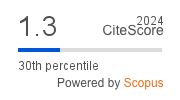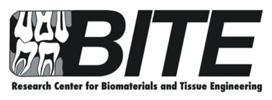Retention of CAD PEEK versus metallic partial denture frameworks in patients with mandibular Kennedy Class I
Downloads
Background: Traditionally, removable partial denture (RPD) frameworks have been made from metal alloys, with patients expressing dissatisfaction regarding esthetics, metallic taste, and weight. Several attempts have been made to introduce new materials suitable for RPD frameworks. Purpose: This study aims to compare the retention of polyetheretherketone (PEEK) and metallic computer-aided designed (CAD) removable partial dentures (RPD) in patients with mandibular Kennedy Class I. Methods: Twenty-four patients with Kennedy Class I partially edentulous mandibles were randomly assigned to two parallel groups. Computer-aided design of the RPD’s frameworks was used to produce a sacrificial resin pattern, then cast into cobalt chromium (Co-Cr) or pressed into PEEK to produce RPD frameworks. An acrylic resin denture base and teeth were attached to the framework, processed, finished, polished, and delivered to the patients. Retention in Newtons was measured for both groups by pulling the RPDs from their geographic center at the time of insertion, after one and three months. Results: At each time interval, a repeated measures ANOVA revealed statistically significantly higher mean retention values for the metal group compared to the PEEK group. Retention did not decrease significantly in the PEEK group, whereas a significant retention decrease was observed in the metal group. An independent student’s T-test revealed a significant difference between retention loss for the metal and PEEK groups. Conclusion: Within the limitations of this study, although metal RPD frameworks provide higher mean retention values than PEEK RPD frameworks, both show clinically acceptable retention levels. Nevertheless, PEEK maintains retention more than metal in the short term.
Downloads
Chen Y-W, Li C-Y, Lee S-C, Ku L-JE, Chou Y-T, Hargono A, Chiu C, Hou W-H. Associations among tooth loss, denture use, and dementia in older Taiwanese adults. J Chinese Med Assoc. 2025; 88(1): 43–51. doi: https://doi.org/10.1097/JCMA.0000000000001171
Ari MDA, Laksono H, Laksono V, Sanjaya RAA, Pramesti TR, Sitalaksmi RM. Management of a complete denture in the flat mandibular ridge using a semi-adjustable articulator along with an effective suction method. Dent J. 2022; 55(3): 179–85. doi: https://doi.org/10.20473/j.djmkg.v55.i3.p179-185
Subiakto BDS, Kresnoadi U. Telescopic overdenture as an alternative rehabilitation for the loss of several anterior teeth due to traffic accidents. Dent J. 2020; 53(3): 126–32. doi: https://doi.org/10.20473/j.djmkg.v53.i3.p126-132
Kamadjaja MJK, Rahmawati NP, Waluyo WH. Use of metal frame removable partial denture in rheumatoid arthritis: a case report. J Med Chem Sci. 2023; 6(8): 1878–84. doi: https://doi.org/10.26655/JMCHEMSCI.2023.8.16
Hartono CK, Hendrijantini N, Soekobagiono. Bilateral mandibular posterior edentulous rehabilitation for unstable occlusion patient with bilateral attachment retained mandibular removable partial denture. Acta Med Philipp. 2019; 53(6): 547–57. doi: https://doi.org/10.47895/amp.v53i6.709
Barreto AO, de Aquino LMM, de Aquino ARL, Roncalli AG, do Amaral BA, da Fonte Porto Carreiro A. Impact on quality of life of removable partial denture wearers after 2 years of use. Brazilian J Oral Sci. 2011; 10(1): 50–4. web: http://revodonto.bvsalud.org/scielo.php?script=sci_arttext&pid=S1677-32252011000100010
Akl MA, Stendahl CG. Removable partial denture frameworks in the age of digital dentistry: A review of the literature. Prosthesis. 2022; 4(2): 184–201. doi: https://doi.org/10.3390/prosthesis4020019
Hu F, Pei Z, Wen Y. Using intraoral scanning technology for three-dimensional printing of kennedy class i removable partial denture metal framework: A clinical report. J Prosthodont. 2019; 28(2): e473–6. doi: https://doi.org/10.1111/jopr.12712
Saad A, Abbas FSA, Elgharabawy SHE. Clinical evaluation of removable partial denture constructed from 3D printed resin pattern designed using CAD CAM technology. Alexandria Dent J. 2019; 44(2): 15–21. doi: https://doi.org/10.21608/adjalexu.2019.57357
Hundal M, Madan R. Comparative clinical evaluation of removable partial dentures made of two different materials in Kennedy Applegate class II partially edentulous situation. Med J Armed Forces India. 2015; 71(Suppl 2): S306–12. doi: https://doi.org/10.1016/j.mjafi.2012.08.020
Savitri IJ, Wijaksana IKE, Arief O, Falah MN, Tedjosasongko U, Siswanto OB, Ouhara K, Kurihara H, Mizuno N. Aesthetic consideration in patient management of severe periodontitis aggravated by oral dexamethasone. Dent J. 2023; 56(2): 73–9. doi: https://doi.org/10.20473/j.djmkg.v56.i2.p73-79
Mohamed T, Baraka OA, Badawy MM. Comparison between acetal resin and cobalt-chromium removable partial denture clasp retention: an in vitro study. Int J Prosthodont Restor Dent. 2013; 3(2): 50–6. doi: https://doi.org/10.5005/jp-journals-10019-1076
Zoidis P, Papathanasiou I, Polyzois G. The use of a modified poly-ether-ether-ketone (PEEK) as an alternative framework material for removable dental prostheses. A clinical report. J Prosthodont. 2016; 25(7): 580–4. doi: https://doi.org/10.1111/jopr.12325
Fueki K, Ohkubo C, Yatabe M, Arakawa I, Arita M, Ino S, Kanamori T, Kawai Y, Kawara M, Komiyama O, Suzuki T, Nagata K, Hosoki M, Masumi S, Yamauchi M, Aita H, Ono T, Kondo H, Tamaki K, Matsuka Y, Tsukasaki H, Fujisawa M, Baba K, Koyano K, Yatani H. Clinical application of removable partial dentures using thermoplastic resin—Part I: Definition and indication of non-metal clasp dentures. J Prosthodont Res. 2014; 58(1): 3–10. doi: https://doi.org/10.1016/j.jpor.2013.12.002
Chen F, Ou H, Lu B, Long H. A constitutive model of polyether-ether-ketone (PEEK). J Mech Behav Biomed Mater. 2016; 53(1): 427–33. doi: https://doi.org/10.1016/j.jmbbm.2015.08.037
Georgiev J, Vlahova A, Kissov H, Aleksandrov S, Kazakova R. Possible application of biohpp in prosthetic dentistry: a literature review. J IMAB - Annu Proceeding (Scientific Pap. 2018; 24(1): 1896–8. doi: https://doi.org/10.5272/jimab.2018241.1896
Costa-Palau S, Torrents-Nicolas J, Brufau-de Barberà M, Cabratosa-Termes J. Use of polyetheretherketone in the fabrication of a maxillary obturator prosthesis: A clinical report. J Prosthet Dent. 2014; 112(3): 680–2. doi: https://doi.org/10.1016/j.prosdent.2013.10.026
Yamamoto ETC, Sato TP, Da Silva JMF, Borges ALS, Uemura ES. Retentive force comparison between esthetic and metal clasps for removable partial denture. Brazilian Dent Sci. 2017; 20(3): 87–92. doi: https://doi.org/10.14295/bds.2017.v20i3.1431
Peng T-Y, Ogawa Y, Akebono H, Iwaguro S, Sugeta A, Shimoe S. Finite-element analysis and optimization of the mechanical properties of polyetheretherketone (PEEK) clasps for removable partial dentures. J Prosthodont Res. 2020; 64(3): 250–6. doi: https://doi.org/10.1016/j.jpor.2019.07.012
Tribst JPM, Dal Piva AM de O, Borges ALS, Araújo RM, da Silva JMF, Bottino MA, Kleverlaan CJ, de Jager N. Effect of different materials and undercut on the removal force and stress distribution in circumferential clasps during direct retainer action in removable partial dentures. Dent Mater. 2020; 36(2): 179–86. doi: https://doi.org/10.1016/j.dental.2019.11.022
Maryod WH, Rekaby Taha E. Comparison of the retention of conventional versus digitally fabricated removable partial dentures. A cross over study. Int J Dent Oral Heal. 2019; 5(2): 13–9. web: https://www.biocorepublishinggroup.com/ijdoh/Comparison-of-the-Retention-of-Conventional-Versus-Digitally-Fabricated-Removable-Partial-Dentures-A-Cross-Over-Study.pdf
Gonçalves TMSV, Campos CH, Rodrigues Garcia RCM. Implant retention and support for distal extension partial removable dental prostheses: Satisfaction outcomes. J Prosthet Dent. 2014; 112(2): 334–9. doi: https://doi.org/10.1016/j.prosdent.2013.11.004
Dawid M-T, Moldovan O, Rudolph H, Kuhn K, Luthardt RG. Technical complications of removable partial dentures in the moderately reduced dentition: A systematic review. Dent J. 2023; 11(2): 55. doi: https://doi.org/10.3390/dj11020055
Lyu H, Murakami N, Yamazaki T, Wada J, Utsumi M, Wakabayashi N. Evaluation of PEEK and zirconia occlusal rest designs for removable partial dentures based on finite element analysis. J Prosthodont Res. 2023; 67(2): 196–205. doi: https://doi.org/10.2186/jpr.JPR_D_22_00011
Alageel O, Alsheghri AA, Algezani S, Caron E, Tamimi F. Determining the retention of removable partial dentures. J Prosthet Dent. 2019; 122(1): 55-62.e3. doi: https://doi.org/10.1016/j.prosdent.2018.06.015
Kabeel SM, Bahaa SM, Shaaban SM. Assessment of retention in cases of Kennedy class I partial dentures fabricated by CAD-CAM milled resin technology. Eur Chem Bull. 2023; 12(1): 3926–35. web: https://www.eurchembull.com/archives/volume-12/issue-1
Refai OM, Nawar NH, Lebshtien IT. Assessment of retention of CAD-CAM milled PEKK vs PEEK double crown-retained removable partial dentures: A randomized clinical trial. J Contemp Dent Pract. 2022; 22(11): 1250–6. doi: https://doi.org/10.5005/jp-journals-10024-3233
Mayinger F, Micovic D, Schleich A, Roos M, Eichberger M, Stawarczyk B. Retention force of polyetheretherketone and cobalt-chrome-molybdenum removable dental prosthesis clasps after artificial aging. Clin Oral Investig. 2021; 25(5): 3141–9. doi: https://doi.org/10.1007/s00784-020-03642-5
El Mekawy N, Gad ES. Retentive force and surface roughness of partial removable frameworks fabricated from conventional chrome-cobalt and CAD/CAM modified poly-ether-ether-ketone materials (within subject evaluation). Egypt Dent J. 2016; 62(4): 5055–62. web: https://www.researchgate.net/publication/312446401
Gentz FI, Brooks DI, Liacouras PC, Petrich A, Hamlin CM, Ellert DO, Ye L. Retentive forces of removable partial denture clasp assemblies made from polyaryletherketone and cobalt-chromium: A comparative study. J Prosthodont. 2022; 31(4): 299–304. doi: https://doi.org/10.1111/jopr.13398
Muhsin SA, Wood DJ, Johnson A, Sereno N, Hatton P V. Effects of novel polyetheretherketone (PEEK) clasp design on retentive force at different tooth undercuts. JODR. 2018; 5(2): 13–25. web: https://www.researchgate.net/publication/328118341
Vaddamanu SK, Alhamoudi FH, Chaturvedi S, Alqahtani NM, Addas MK, Alfarsi M Al, Vyas R, Kanji MA, Zarbah MA, Alqahtani WMS, Alqahtani SM, Abdelmonem AM, Elmahdi AE. Retentive forces and deformation of fitting surface in RPD clasp made of polyether-ether-ketone (PEEK). Polymers (Basel). 2023; 15(4): 956. doi: https://doi.org/10.3390/polym15040956
Heikal MMA, Nabi NA, Elkerdawy MW. A study comparing patient satisfaction and retention of CAD/CAM milled complete dentures and 3D printed CAD/CAM complete dentures versus conventional complete dentures: a randomized clinical trial. Brazilian Dent Sci. 2022; 25(1): e2785. doi: https://doi.org/10.4322/bds.2022.e2785
Copyright (c) 2025 Dental Journal (Majalah Kedokteran Gigi)

This work is licensed under a Creative Commons Attribution-ShareAlike 4.0 International License.
- Every manuscript submitted to must observe the policy and terms set by the Dental Journal (Majalah Kedokteran Gigi).
- Publication rights to manuscript content published by the Dental Journal (Majalah Kedokteran Gigi) is owned by the journal with the consent and approval of the author(s) concerned.
- Full texts of electronically published manuscripts can be accessed free of charge and used according to the license shown below.
- The Dental Journal (Majalah Kedokteran Gigi) is licensed under a Creative Commons Attribution-ShareAlike 4.0 International License

















